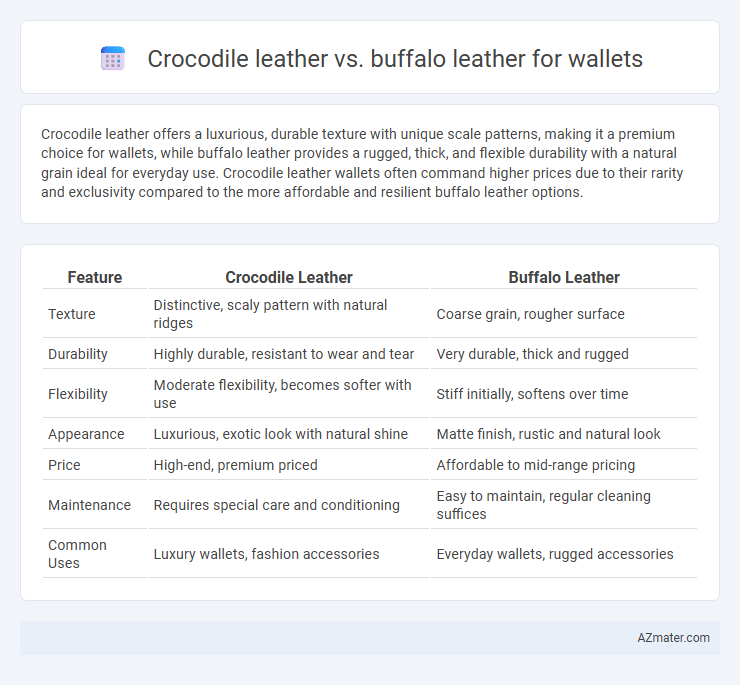Crocodile leather offers a luxurious, durable texture with unique scale patterns, making it a premium choice for wallets, while buffalo leather provides a rugged, thick, and flexible durability with a natural grain ideal for everyday use. Crocodile leather wallets often command higher prices due to their rarity and exclusivity compared to the more affordable and resilient buffalo leather options.
Table of Comparison
| Feature | Crocodile Leather | Buffalo Leather |
|---|---|---|
| Texture | Distinctive, scaly pattern with natural ridges | Coarse grain, rougher surface |
| Durability | Highly durable, resistant to wear and tear | Very durable, thick and rugged |
| Flexibility | Moderate flexibility, becomes softer with use | Stiff initially, softens over time |
| Appearance | Luxurious, exotic look with natural shine | Matte finish, rustic and natural look |
| Price | High-end, premium priced | Affordable to mid-range pricing |
| Maintenance | Requires special care and conditioning | Easy to maintain, regular cleaning suffices |
| Common Uses | Luxury wallets, fashion accessories | Everyday wallets, rugged accessories |
Introduction to Exotic and Traditional Leathers
Crocodile leather, an exotic material known for its distinctive scale patterns and high durability, is prized for luxury wallets that offer unique texture and prestige. Buffalo leather, a traditional choice, provides robust strength and natural grain, ensuring long-lasting performance and a classic, rugged aesthetic. Both leathers cater to different preferences, balancing exclusivity with everyday practicality in wallet craftsmanship.
What is Crocodile Leather?
Crocodile leather is a luxury material derived from the hide of crocodiles, known for its distinctive scale patterns and exceptional durability. This type of leather offers a unique texture and high resistance to wear, making it ideal for premium wallets that combine elegance with long-lasting quality. Compared to buffalo leather, crocodile leather is rarer, often more expensive, and prized for its exotic appearance and natural water resistance.
What is Buffalo Leather?
Buffalo leather is a durable, full-grain leather made from the hide of water buffaloes, known for its natural grain patterns and strength. Compared to crocodile leather, buffalo leather offers a more rugged texture and superior resistance to wear and tear, making it ideal for everyday wallets. Its affordability and robustness make it a popular choice for high-quality, long-lasting leather goods.
Appearance and Texture Comparison
Crocodile leather showcases a distinctive, irregular scale pattern with a glossy finish that exudes luxury and exclusivity, making it highly sought after for premium wallets. In contrast, buffalo leather features a coarser grain with a matte or semi-gloss surface, offering a rugged and durable texture favored for everyday use. The supple yet firm feel of crocodile leather contrasts with buffalo's thicker, more textured surface, influencing both the aesthetic appeal and tactile experience of the wallet.
Durability and Longevity
Crocodile leather offers exceptional durability due to its dense, natural scales and resistance to wear, making it a premium choice for long-lasting wallets. Buffalo leather is also highly durable, featuring a thick, rugged texture that withstands daily use and develops a rich patina over time. While both materials ensure longevity, crocodile leather generally maintains its structural integrity and aesthetic appeal longer under regular wear and tear.
Cost and Value Differences
Crocodile leather wallets are significantly more expensive than buffalo leather due to their rarity, unique texture, and labor-intensive tanning process, often costing several times more. Buffalo leather offers excellent durability and a robust, grainy texture at a more affordable price point, making it a practical choice for everyday use. The value of crocodile leather lies primarily in its luxury appeal and exclusivity, while buffalo leather emphasizes cost-effectiveness and long-lasting functionality.
Maintenance and Care Requirements
Crocodile leather requires meticulous maintenance, including regular conditioning with specialized oils to prevent drying and cracking, making it less forgiving to neglect compared to buffalo leather. Buffalo leather is more durable and resistant to scratches and stains, needing only occasional cleaning and moisturizing to maintain its rugged texture. Both materials benefit from avoiding prolonged exposure to moisture and direct sunlight to preserve their quality and appearance.
Ethical and Environmental Considerations
Crocodile leather, often sourced from exotic animals, raises significant ethical concerns due to wildlife conservation issues and the potential impact on endangered species populations. Buffalo leather, derived from domesticated animals, generally presents a more sustainable option with less environmental strain, as it often utilizes by-products of the meat industry, reducing waste. Both materials involve tanning processes that may affect the environment, but buffalo leather typically benefits from more established, eco-friendly treatment methods in leather production.
Style and Status Symbol
Crocodile leather wallets exude luxury and exclusivity, often associated with high status due to their unique scale patterns and rarity. Buffalo leather wallets offer a rugged yet refined style, prized for durability and a natural grain that enhances with age. Choosing crocodile leather signals a bold fashion statement, while buffalo leather conveys timeless sophistication and strength.
Choosing the Right Leather for Your Wallet
Crocodile leather offers a distinctive, luxurious texture with high durability, making it a premium choice for wallets that stand out and age beautifully. Buffalo leather, known for its robustness and natural grain, provides excellent resistance to wear and a more affordable, rugged alternative ideal for everyday use. Selecting between crocodile and buffalo leather depends on your preference for exclusivity and style versus practicality and longevity.

Infographic: Crocodile leather vs Buffalo leather for Wallet
 azmater.com
azmater.com